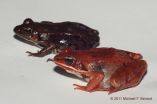(Press-News.org) Scientists have found amphibians worldwide are breeding earlier due to climate change, but how that affects species is just now being answered.
After warmer winters, wood frogs breed earlier and produce fewer eggs, a Case Western Reserve University researcher has found.
Michael F. Benard, the George B. Mayer Chair in Urban and Environmental Studies and assistant professor of biology, also found that frogs produce more eggs during winters with more rain and snow.
Benard's study, published today in the journal Global Change Biology, is among the first in a natural habitat to measure the consequences of one of the major effects of climate change: warmer temperatures that lead to earlier breeding in amphibians and other animals.
Benard also found that when wood frogs breed early in the year, their offspring have delayed development but still metamorphose earlier in the year. He identified the broad patterns by examining and tracking important life events of more than 50,000 juvenile and hundreds of adult wood frogs over seven years and comparing the data to winter weather records.
"There have been lab studies on the effects of warming on frog breeding, but what we see in the lab is not exactly what we're seeing in the field," Benard said.
Wood frogs, found from Alabama to Alaska, literally must thaw out from winter. Biologists believe they breed after temperatures and precipitation reach a certain threshold over a number of days. But the exact formula is unknown. During breeding, each female lays all of her eggs in one mass, called a clutch, which makes egg-counting possible.
After analyzing data collected from 2006 to 2012, Benard found that for every degree Celsius increase in average daily maximum winter temperature:
Wood frogs bred 4.2 days earlier.
The number of eggs per clutch collected in the ponds decreased 3.3 percent, or 24 eggs.
The number of eggs per clutch collected from frogs that had been marked and placed in buckets of water to breed decreased 4.3 percent, or 31 eggs.
"The decrease in eggs per clutch is likely due to increased energy consumption by the females during warmer winters," Benard explained.
The frogs produce a kind of anti-freeze that prevents their cells from freezing. But the fluid between cells freezes, and the animals' heartbeat and breathing halts in subzero temperatures. If frogs stay frozen longer, their metabolism is greatly reduced.
Opposite to warming, more rain and snow appear to have a positive effect on egg production. For every 2.5-centimeter increase in total precipitation, the number of eggs per clutch increased 2.3 percent, or 16.5 eggs. The reason is uncertain, but with climate change expected to increase rainfall in some regions, the effect may help counter potential losses associated with warming.
Benard found no effect of breeding date on tadpole survival or their size at metamorphosis. But earlier breeding was associated with delayed tadpole development due to a counter-intuitive effect of warmer winters on the temperatures that tadpoles experience. It turns out that although earlier breeding is triggered by warmer winters, when breeding occurs earlier, the pond water in which tadpoles develop is colder than if breeding took place in later spring. Colder water likely slowed the advancement from egg to metamorphosis.
Although tadpole development was slowed, for every two days earlier that breeding took place, metamorphosis was a day earlier.
"Earlier metamorphosis potentially increases survivorship," Benard said. "Other studies have found that, after a longer summer growth period, amphibians were larger come winter and had better chances of surviving the cold, predators and disease.
"I'm not sure that's the case here," he said. "That will take more study."
Benard was a fellow in the University of Michigan's Society of Fellows when he began the study at six ponds in the university's E.S. George Reserve, a 1,300-acre research station in southeastern Michigan. Temperatures were recorded by a nearby weather station.
INFORMATION:
The University of Michigan, the Michigan Society of Fellows and Case Western Reserve provided support and funding for the research. Benard is now continuing the study in Northeast Ohio.
Climate change appears a mixed bag for a common frog
Researcher finds effects of earlier breeding and weather
2014-09-29
ELSE PRESS RELEASES FROM THIS DATE:
After-school exercise program enhances cognition in 7-, 8- and 9-year-olds
2014-09-29
CHAMPAIGN, Ill. — A nine-month-long, randomized controlled trial involving 221 prepubescent children found that those who engaged in moderate-to-vigorous physical activity for at least 60 minutes a day after school saw substantial improvements in their ability to pay attention, avoid distraction and switch between cognitive tasks, researchers report in the journal Pediatrics.
Half of the study subjects were randomly assigned to the after-school program and the rest were placed on a wait list. All participants underwent cognitive testing and brain imaging before and after ...
Hand size appears to stay constant, providing natural 'ruler'
2014-09-29
People tend to perceive their dominant hand as staying relatively the same size even when it's magnified, lending support to the idea that we use our hand as a constant perceptual "ruler" to measure the world around us. The findings are published in Psychological Science, a journal of the Association for Psychological Science.
"These findings suggest that our bodies are used as perceptual metrics, meaning that we are more likely to attribute changes in the perceived size of the hand to changes in the world — instead of thinking that our hand has become bigger, we're more ...
More children admitted to intensive care but with lower staffing ratios
2014-09-29
More children than ever are being admitted to intensive care units in England and Wales but there are fewer staff per bed available to cope with the increase, according to a new report published jointly by the University of Leeds and University of Leicester.
The Paediatric Intensive Care Audit Network (PICANet) report showed that there was a 15% increase in admissions over a 10-year period between 2004 and 2013, but this included an increase of 4% that was not due to changes in the childhood population.
At the same time, staffing levels have increased by 36% but this ...
Researchers identify early sign of pancreatic cancer
2014-09-28
BOSTON –– Scientists at Dana-Farber Cancer Institute, the Massachusetts Institute of Technology, and other institutions have discovered a sign of the early development of pancreatic cancer – an upsurge in certain amino acids that occurs before the disease is diagnosed and symptoms appear. The research is being published online today by the journal Nature Medicine.
Although the increase isn't large enough to be the basis of a new test for early detection of the disease, the findings will help researchers better understand how pancreatic cancer affects the rest of the body, ...
Human genome was shaped by an evolutionary arms race with itself
2014-09-28
New findings by scientists at the University of California, Santa Cruz, suggest that an evolutionary arms race between rival elements within the genomes of primates drove the evolution of complex regulatory networks that orchestrate the activity of genes in every cell of our bodies.
The arms race is between mobile DNA sequences known as "retrotransposons" (a.k.a. "jumping genes") and the genes that have evolved to control them. The UC Santa Cruz researchers have, for the first time, identified genes in humans that make repressor proteins to shut down specific jumping ...
Docetaxel or pemetrexed with cisplatin achieve comparable outcomes in non-squamous Lu Ca
2014-09-27
The first direct comparison of treating non-squamous lung cancer with either pemetrexed or docetaxel in addition to cisplatin has shown that the two combinations achieve similar progression-free survival, although docetaxel was associated with more frequent adverse events.
At the ESMO 2014 Congress in Madrid, Dr Young-Chul Kim from Chonnam National University Medical School, South Korea, reported the results of an open-label phase III trial that included 149 patients with non-squamous non-small cell lung cancer (NSCLC) conducted at 14 centres in South Korea.
"We wanted ...
Customising chemotherapy in Lu Ca: New Ph II data reported in 2 LB studies
2014-09-27
Measuring the expression levels of an enzyme involved in DNA synthesis can help predict the response of lung cancers to certain treatments, a Korean study has shown at the ESMO 2014 Congress in Madrid.
In a randomized phase II study, researchers showed that patients whose lung cancers expressed low levels of an enzyme called thymidylate synthase experienced a greater benefit from treatment with the combination of pemetrexed and cisplatin than those whose tumours expressed high levels.
"Thymidylate synthase is one of the proteins that is targeted by pemetrexed which ...
French studies measure benefits of colorectal cancer screening
2014-09-27
The introduction of biennial colorectal cancer screening in a region of France increased the rate of diagnosis of high risk pre-cancerous adenomas (sometimes called polyps) by 89%, researchers have reported at the ESMO 2014 Congress in Madrid.
Dr Vanessa Cottet from INSERM Unité 866 in Dijon, France, and colleagues studied the region of Côte-d'Or, where a registry has been collecting data on adenomas since 1976. They wanted to evaluate the rate of diagnosis of adenomas before and after the initiation of a screening program using fecal occult blood testing that began ...
Crizotinib treatment effective against ROS1-positive lung cancer
2014-09-27
Treatment with the targeted therapy drug crizotinib effectively halts the growth of lung tumors driven by rearrangements of the ROS1 gene. In an article receiving Online First publication in the New England Journal of Medicine to coincide with a presentation at the European Society for Medical Oncology meeting, an international research team reports that crizotinib treatment led to significant tumor shrinkage in 36 of 50 study participants and suppressed tumor growth in another 9.
"Prior to this study, there were a handful of reports describing marked responses to crizotinib ...
Cancer during pregnancy: Chemotherapy and radiotherapy are safe for babies, studies show
2014-09-27
Children who are exposed to chemotherapy or radiotherapy while in the womb suffer no negative impacts on mental or cardiac development, international studies presented at the ESMO 2014 Congress in Madrid have shown.
"When chemotherapy is administered after the first trimester of pregnancy, we cannot discern any problems in the children," says lead author Dr Frederic Amant, KU Leuven and University Hospitals Leuven in Belgium. "Fear about the risks of chemotherapy administration should not be a reason to terminate a pregnancy, delay cancer treatment for the mother, or ...
LAST 30 PRESS RELEASES:
Heart-brain connection: international study reveals the role of the vagus nerve in keeping the heart young
Researchers identify Rb1 as a predictive biomarker for a new therapeutic strategy in some breast cancers
Survey reveals ethical gaps slowing AI adoption in pediatric surgery
Stimulant ADHD medications work differently than thought
AI overestimates how smart people are, according to HSE economists
HSE researchers create genome-wide map of quadruplexes
Scientists boost cell "powerhouses" to burn more calories
Automatic label checking: The missing step in making reliable medical AI
Low daily alcohol intake linked to 50% heightened mouth cancer risk in India
American Meteorological Society announces Rick Spinrad as 2026 President-Elect
Biomass-based carbon capture spotlighted in newly released global climate webinar recording
Illuminating invisible nano pollutants: advanced bioimaging tracks the full journey of emerging nanoscale contaminants in living systems
How does age affect recovery from spinal cord injury?
Novel AI tool offers prognosis for patients with head and neck cancer
Fathers’ microplastic exposure tied to their children’s metabolic problems
Research validates laboratory model for studying high-grade serous ovarian cancer
SIR 2026 delivers transformative breakthroughs in minimally invasive medicine to improve patient care
Stem Cell Reports most downloaded papers of 2025 highlight the breadth and impact of stem cell research
Oxford-led study estimates NHS spends around 3% of its primary and secondary care budget on the health impacts of heat and cold in England
A researcher’s long quest leads to a smart composite breakthrough
Urban wild bees act as “microbial sensors” of city health.
New study finds where you live affects recovery after a hip fracture
Forecasting the impact of fully automated vehicle adoption on US road traffic injuries
Alcohol-related hospitalizations from 2016 to 2022
Semaglutide and hospitalizations in patients with obesity and established cardiovascular disease
Researchers ‘listen in’ to embryo-mother interactions during implantation using a culture system replicating the womb lining
How changing your diet could help save the world
How to make AI truly scalable and reliable for real-time traffic assignment?
Beyond fragmented markets: A new framework for efficient and stable ride-pooling
Can shape priors make road perception more reliable for autonomous driving?
[Press-News.org] Climate change appears a mixed bag for a common frogResearcher finds effects of earlier breeding and weather




